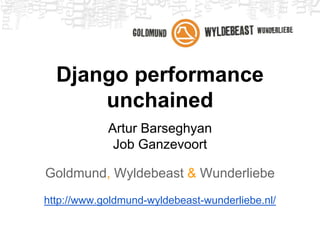This document discusses optimizing Django performance. It begins by describing the server, Apache, database, and Django configurations. It then discusses optimizing various aspects of the Django project like the ORM, database queries, template rendering, caching, and DjangoCMS-specific optimizations. Key recommendations include using select_related, prefetch_related, batch database operations to avoid queries in loops, optimizing templates, reducing cache misses, and handling {% page_url %} tags efficiently in DjangoCMS projects. The document provides examples of inefficient code and more optimized alternatives.
















































![Good example
authors_list = []
for __i in range(1, 50):
author = Author(
salutation='Something %s' % uuid.uuid4(),
name='Some name %s' % uuid.uuid4(),
email='name%s@example.com' % uuid.uuid4()
)
authors_list.append(author)
Author.objects.bulk_create(authors_list)](https://image.slidesharecdn.com/pygrunntalk2017-slides-170519094147/85/PyGrunn-2017-Django-Performance-Unchained-slides-49-320.jpg)















![Improved example
# Freeze the queryset
items = Item.objects.all()[:]
# Collect all page ids
page_ids = [item.page_id for item in items]
pages = Page.objects.filter(id__in=page_ids)
pages_dict = {page.id: page for page in pages}
for item in items:
page = pages_dict.get(item.page_id)
# ... do something else with item](https://image.slidesharecdn.com/pygrunntalk2017-slides-170519094147/85/PyGrunn-2017-Django-Performance-Unchained-slides-65-320.jpg)








![Hold on, there’s a way to fix it!
# Some sort of a fake page container, to trick django-cms.
PageData = namedtuple('PageData', ['pk'])
class MyView(View):
def get(self, request):
# This is to trick the django-cms middleware, so that we don't
# fetch page from the request (not needed here).
request._current_page_cache = PageData("_")
context = self.get_context(request)
return render_to_response(
self.template_name),
context,
request
)](https://image.slidesharecdn.com/pygrunntalk2017-slides-170519094147/85/PyGrunn-2017-Django-Performance-Unchained-slides-74-320.jpg)






![Improved example (page 1)
pages = Page.objects.all()[]
page_ids = [page.id for page in pages]
titles = Title.objects
.filter(language=get_language())
.filter(page__id__in=page_ids)
.select_related('page', 'page__publisher_public', 'page__site')
.only('id', 'title', 'slug', 'path', 'page__id', 'page__reverse_id',
'page__publisher_is_draft',
'page__publisher_public__publisher_is_draft',
'page__publication_date', 'page__publication_end_date',
'page__site', 'page__is_home', 'page__revision_id')[:]](https://image.slidesharecdn.com/pygrunntalk2017-slides-170519094147/85/PyGrunn-2017-Django-Performance-Unchained-slides-81-320.jpg)
![Improved example (page 2)
pages_dict = {}
for _title in titles:
if not hasattr(_title.page, 'title_cache'):
_title.page.title_cache = {}
_title.page.title_cache[get_language()] = _title
pages_dict[_title.page.id] = _title.page
_pages = []
for page in pages:
_pages.append(page_dict.get(page.id, page))
pages = _pages](https://image.slidesharecdn.com/pygrunntalk2017-slides-170519094147/85/PyGrunn-2017-Django-Performance-Unchained-slides-82-320.jpg)





















